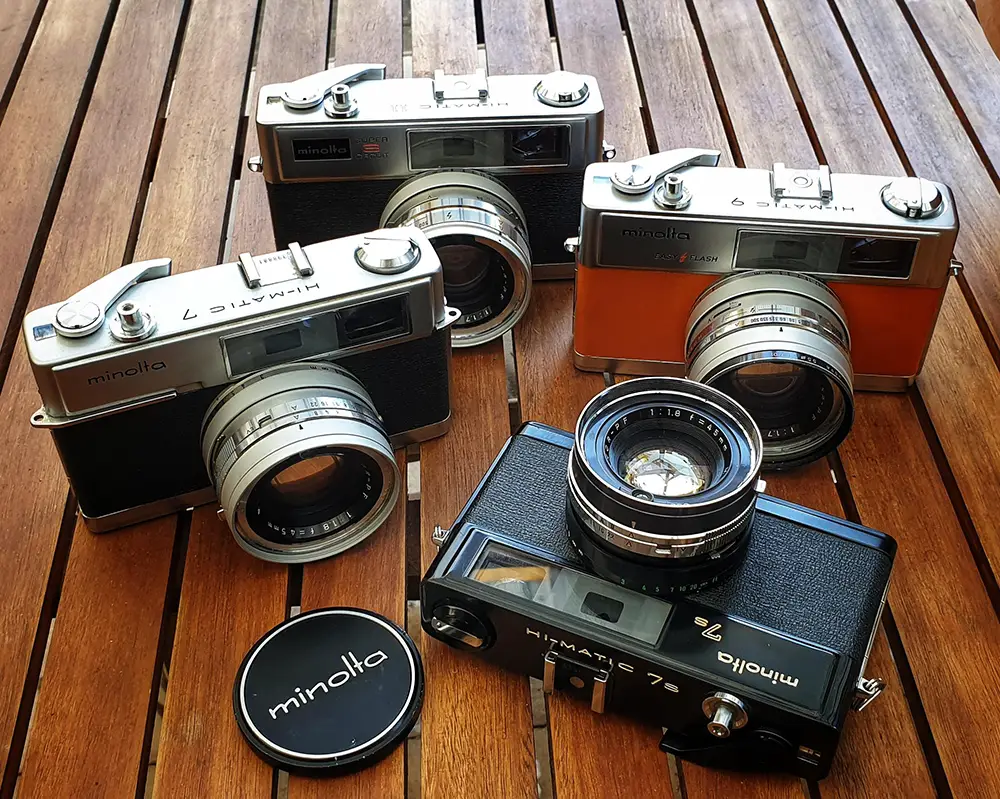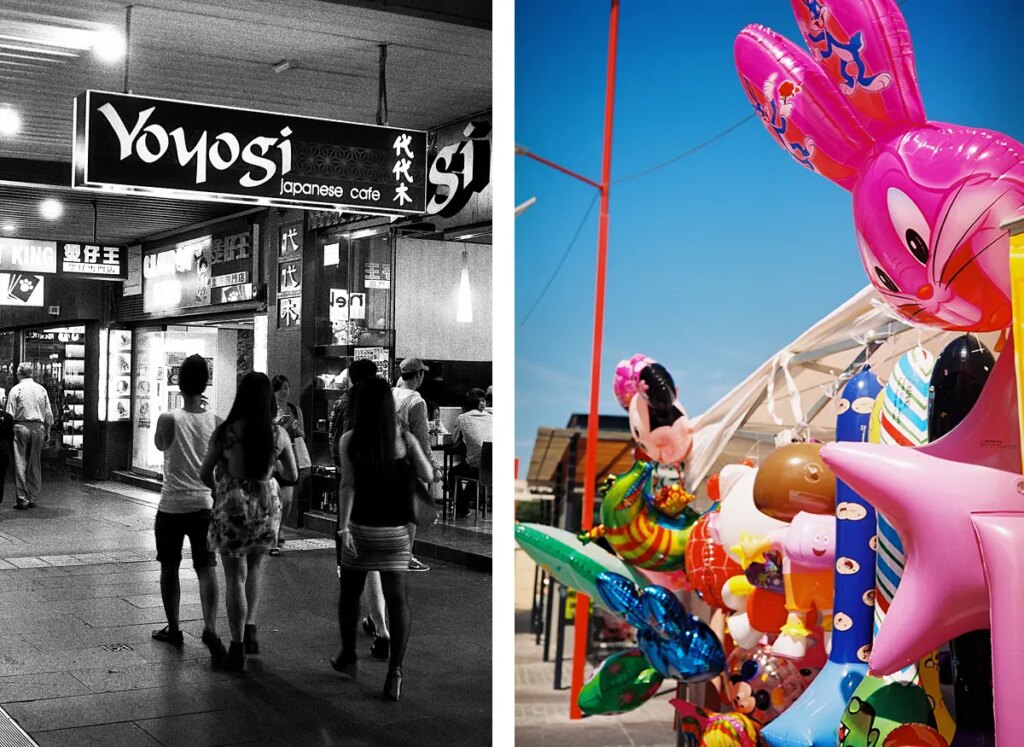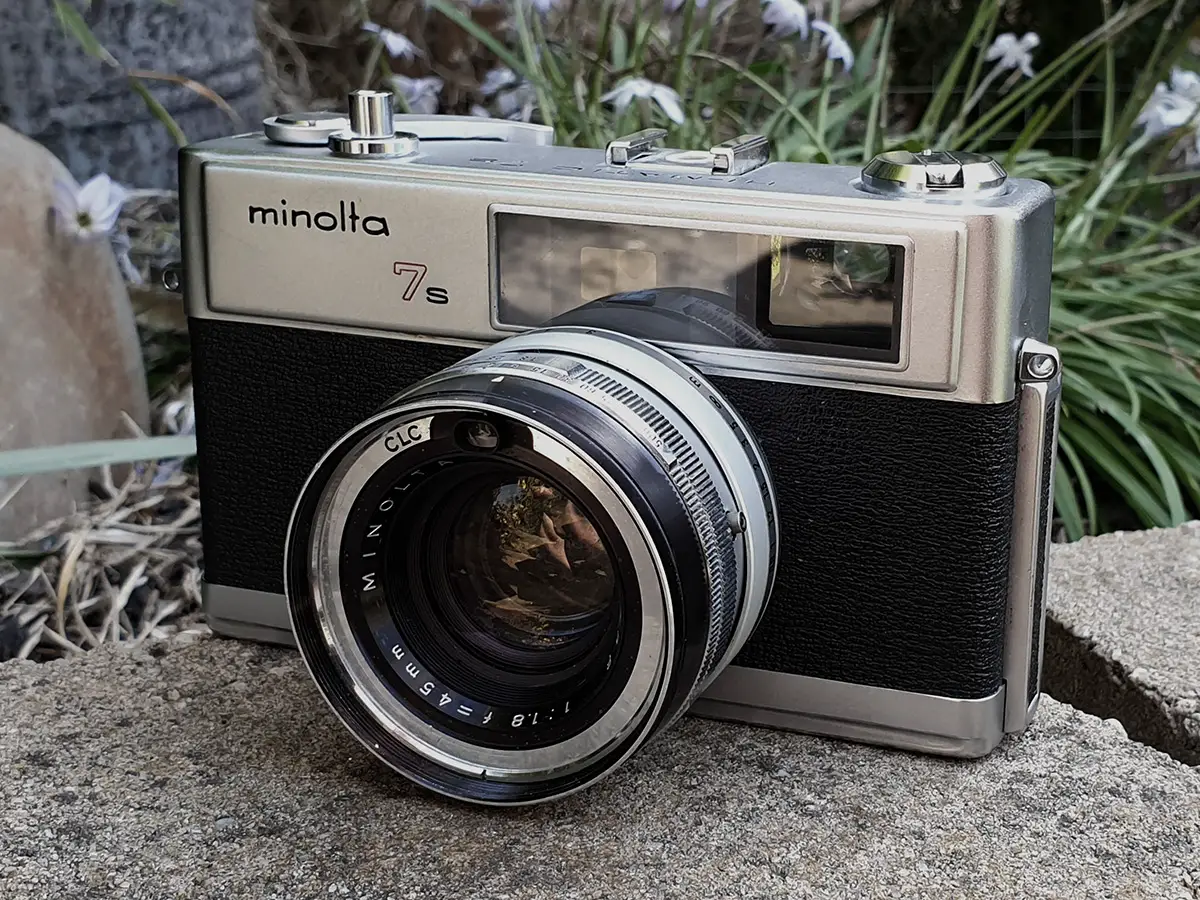As with most photographers over a certain age, I began my photography shooting film back in the late 1980s. By the mid 2000s I was shooting only digital for work and decided to get rid of almost all my film gear. Then around 2012 a wave of nostalgia overcame me and I decided to get myself back into shooting film. I decided to go for a Hi-Matic 7s as that was what I remember as our family camera when I was growing up and I happened to think it’s a very elegant looking rangefinder camera. Hipsters would look on in envy as I’d pass them by, camera dangling from my wrist from a hand crafted leather strap…
Part One: A short review…
…of the camera that got me hooked on collecting and also got me back into shooting film.
The original Hi-Matic was released in 1962 and featured a large selenium meter on the front plate and featured fully automatic exposure and an f2 orf 2.8 lens. Nothing really to write home about. However in 1963 they followed up with the Hi-Matic 7 and in 1966 the 7s and the 9. The final (full sized) version was the Hi-Matic 11 which came out in 1969.
The Hi-Matic 7s (and Hi-Matic 9) is, in my opinion the pick of the bunch as it has the best feature set.
The Good
The 7s has a 45mm f1.8 lens with a 55mm filter thread. The light meter (a CDS cell) is within the filter ring so you don’t need to worry about compensating for any filters. Coating is very good at controlling flare even when shooting directly at a light source. For the nerds out there it has 6 elements in 5 groups and in my opinion is plenty sharp and contrasty.

Exposure modes are all there. Manual, Aperture Priority, Shutter Priority, Full Auto. And with a Seiko leaf shutter you can get flash sync at all speeds either via the hot shoe or the PC socket.
One of the things I love about this camera is it just feels SOLID. It’s all metal construction means it comes in at close to 750g. To me, it almost has that same indestructible feel of a Nikon F. The viewfinder is also quite large (compared to several other rangefinder cameras I’ve acquired since), very clear with a good size split image area for focusing. Auto parallax correction is also a bonus. ISO range is from 25 to 800 so you’re covered for just about any film you’d care to use. I’ve used 1600 rated film and just compensated my exposures accordingly. So far so good.
Now for the Not so Good
It takes obsolete PX625 batteries. I know you can get Weincell replacements but I’ve just never really taken to them. They cost a heap, the voltage isn’t exactly the same, and once you peel that little sticker off them and expose them to air, the clock is ticking as to how long they’ll last. As I now have quite a number of cameras in my rotation, I might only use it once a year and that’s probably the life of the battery. The other annoyance with this camera is the ridiculously long film advance stroke. Something like 220degrees! You almost need a double jointed wrist to crank it around in one go!
And then the Downright Painfull
It’s an OLD camera. Finding one in good cosmetic condition at a reasonable price isn’t too hard. Most I’ve seen come with the original hard case which offers excellent protection. However as with most old cameras the electronics can be a bit hit and miss.

I now have 6 Hi-Matics and only 3 have working light meters. Due to the very complex construction of these cameras it’s not economical to have them repaired. Getting to where the wiring usually fails is an almost complete disassembly job. If you can do it yourself, great! Otherwise it’s literally cheaper to just keep buying them until you get one which works.
After all that though I’d say that they’re still a great camera. Very underrated which is reflected in the prices you can get them for. The lenses are awesome, they’re solid and I think they just look great. If you get one with a dead meter, just shoot in manual mode and use the Sunny 16 rule or a handheld meter. You’ll be right! The reward is a cool looking camera for not a lot of money which can take great photos.
Part Two: Comparing the different models
Let’s briefly look at the timeline and the features of the other “full size” Hi-Matics. I’ll leave the others such as the Hi-Matic E, F, G series for another time as they’re a completely separate range.
In 1962 Minolta kicked things off with the original Hi-Matic. This is one model I still need to add to my collection in order to complete the set. The original Hi-Matic was a fairly average rangefinder camera for its time. It had a selenium light meter on the front panel and a 45mm f2 or f2.8 lens and fully automatic function. Basically focus and shoot.
In 1963 Minolta stepped things up a bit when they released the Hi-Matic 7. A much more serious camera with an excellent 45mm f1.8 Rokkor lens which had a CDS light meter cell located within the filter ring. This made for much more accurate metering and also meant you didn’t have to calculate any exposure compensation if using filters. Exposure modes now included manual as well as Auto settings. As I’ve said before I think it’s a beautifully designed camera with a hefty and solid feel to it. The lens and feature set isn’t really lacking anything other than a hotshoe. Flash sync on this model is therefore only possible via the PC socket on the lens barrel.
1966 saw the introduction of the Hi-Matic 7s and the Hi-Matic 9. The 7s was an upgrade from the 7 in that it now featured a hotshoe for flash sync and the front portion of the lens barrel was now a sexy black as opposed to silver. The light meter now also featured “CLC”; the same Contrast Light Compensator as introduced on the SRT line of SLRs. I haven’t really done any side by side tests with the 2 models so can’t say whether or not there’s any real world difference.
The Hi-Matic 9 came with a 45mm f1.7 lens and Minolta’s “Easy Flash” system. This basically lets you set the guide number of your flash to a scale on the lens barrel and the camera will apparently do the rest? No idea as to how good this is as I’ve never used it.
Moving along to 1969 and Minolta released the final of their full sized Hi-Matics, the Hi-Matic 11. Now in my opinion this camera is a bit of a step backwards as it’s basically a Full Auto or Shutter Priority camera. No full manual control. Now I can understand why a few manufacturers went with Shutter Priority with their SLRs as this mode lends itself to action and sports photography, but a rangefinder camera with a fixed lens doesn’t fall into that category in my book. Anyway…
The front panel features a new Minolta logo on a black surround and some script proudly announcing “Super 3 Circuit”. Pretty much just means the 3 auto modes of the camera: Full Auto, Shutter Priority Auto, and Auto Flash.

So this rounds out the full size Hi-Matics from Minolta. Apart from the original, I own and have used all of them. Some of them have required nothing more than a clean up while a couple (my Hi-Matic 9 in particular) have required quite serious surgery to get them going. They’re a lovely camera to use; solidly built, excellent optics, bright and clear viewfinders, and the 7s and 9 have a complete feature set which should satisfy anyone. Sure they are now 50 + years old and may or may not have working light meters but unlike some of their contemporaries such as the much more poplular Yashica Electro 35, they will still function as manual cameras even without a battery. The Seiko shutters also don’t seem to suffer from sticking blades as much as similar cameras such as Canonets for instance.
If you’re on a budget, or just want to add a cool looking rangefinder camera capable of taking great photos to your collection, you could do a lot worse than one of these.
Another review of the 7s here
Share this post:









Comments
John Collins on Minolta Hi-Matic 7s – My Gateway Drug into the World of Camera Collecting – By Markus Hainz
Comment posted: 30/09/2022
andy on Minolta Hi-Matic 7s – My Gateway Drug into the World of Camera Collecting – By Markus Hainz
Comment posted: 30/09/2022
Great story - I could almost take over for myself.
I started my 2nd analog photo time in 2018 with the same camera.
Since then, the analog sweethearts have piled up massively, but it's always fun.
But I still own the Hi-Matic 7s because it symbolizes my 2nd entry for me.
Thanks for the story and have a good photo time.
Andy
(instagram.com/f16.ch)
Bob Janes on Minolta Hi-Matic 7s – My Gateway Drug into the World of Camera Collecting – By Markus Hainz
Comment posted: 30/09/2022
I'm intrigued by the 'CLC' thing as my understanding was that CLC required two CdS cells.
Regarding your comments on shutter priority on the 11 - I think they tended to go for shutter priority in some of these older automatics as it was possible to tie in a mechanical shutter with set shutter speeds and a constantly variable aperture - personally I'm generally fine with full auto on this class of camera - aperture priority probably makes a little more sense with a wide aperture lens, but it does require a constantly variable shutter, which adds a complication if the shutter is mechanical...
JAMES LANGMESSER on Minolta Hi-Matic 7s – My Gateway Drug into the World of Camera Collecting – By Markus Hainz
Comment posted: 30/09/2022
Terry B on Minolta Hi-Matic 7s – My Gateway Drug into the World of Camera Collecting – By Markus Hainz
Comment posted: 30/09/2022
This can be seen in the colourful balloons where the colours, and lighting, look so natural.
Comment posted: 30/09/2022
Comment posted: 30/09/2022
Comment posted: 30/09/2022
Michael on Minolta Hi-Matic 7s – My Gateway Drug into the World of Camera Collecting – By Markus Hainz
Comment posted: 30/09/2022